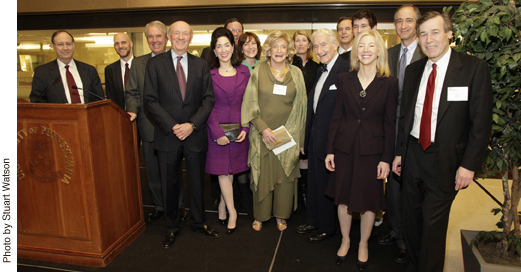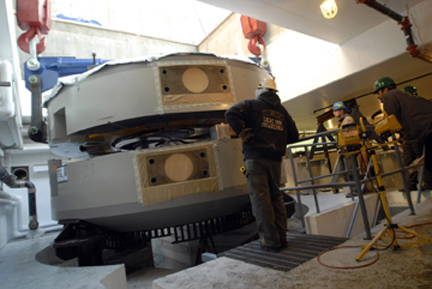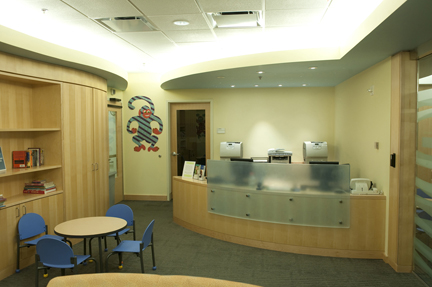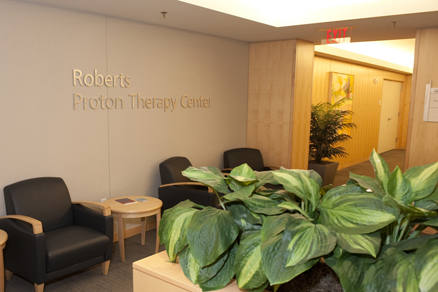| Dedicating the Roberts Proton Therapy Center |
|
December 8, 2009,
Volume 56, No. 14
|
|
| The Center will be led by Dr. Stephen Hahn, the Henry Pancoast Professor and chairman of the Penn Medicine Department of Radiation Oncology. He and Dr. James Metz, vice chair for clinical operations in Radiation Oncology, are in front of one of the gantries at the Roberts Proton Therapy Center. The Center was designed by architects Tsoi, Kobus and Associates. |
Penn Medicine recently celebrated the upcoming opening of the Roberts Proton Therapy Center with an event to honor the many donors and staff members who have made this cutting-edge $140 million radiation therapy facility a reality. Patients from all over the country are expected to come to Penn for this precise form of radiation therapy, which is especially well suited for treating cancers in the brain, head, neck, eye and spinal cord, and in hard-to-reach organs such as the liver, pancreas, and esophagus. Partnerships with the Children’s Hospital of Philadelphia (CHOP) and the US Department of Defense will also allow pediatric cancer patients and US military service members and their family members to be treated in the new center.
The Perelman Center for Advanced Medicine now houses a first-of-its-kind proton therapy center for the treatment of cancer. The Roberts Proton Therapy Center, opening midwinter 2010, was financed in part by a generous gift of $15 million from the Roberts family, a family committed to Philadelphia. University of Pennsylvania alumnus Ralph J. Roberts is the founder of Comcast Corp.
It is located in a mostly underground building interconnected to the Perelman Center for Advanced Medicine. At approximately 75,000 square feet, the Roberts Proton Therapy Center will be the largest proton therapy center associated with an academic medical center in the world and one of only six such centers in the country. It will also be the world’s most comprehensive proton therapy center, offering the unique ability to fully integrate conventional radiation treatment with proton radiation.
The radiation dose that is given through protons is more precise, and the undesirable dose to normal tissues is considerably less. Because of this special quality of protons, the radiation oncologist can increase the dose to the tumor while reducing the dose to surrounding normal tissues. This in turn may allow the dose to be increased beyond that which conventional radiation will allow, resulting in a higher probability of cure and with fewer harmful side effects.
It is projected that the Roberts Proton Therapy Center will treat 3,000 patients a year, including several hundred children, continuing the historically close relationship between Penn Medicine and CHOP.
In addition, Penn has established a new relationship with Walter Reed Army Medical Center, through which proton therapy technology will be available to treat United States military personnel and veterans.
The Robert’s Proton Therapy Center will be the:
• first such facility in the mid-Atlantic region, the only one between Boston and Florida
• first in the world to be fully integrated, on-site, with a renowned cancer center, the Abramson Cancer Center of the University of Pennsylvania
• first proton therapy center to be located on the campus of a world-class academic medical center, a provision that will facilitate scientific research to measure and improve this innovative therapy
• first facility with precise imaging integrated onto the proton equipment, allowing physicians to know precise tumor location at the exact moment of treatment
The Roberts Proton Therapy Center will be comprised of up to five treatment rooms, four gantries (90-ton rotational machines designed to deliver the therapeutic beam at the precise angle prescribed by the physician), and one fixed-beam room. The Roberts Proton Therapy Center will have the most advanced options available for patient positioning and comfort, and will also include a separate research room.
 |
At the Opening Celebration of the Roberts Proton Therapy Center: (left to right) School of Medicine Dean Arthur Rubenstein, Dr. Stephen Hahn, chairman of Radiation Oncology; James Riepe, chairman of the Penn Medicine Board; UPHS CEO Ralph Muller, join the Roberts family on the podium following remarks; Catherine Roberts Clifton, David Cohen, chair of Penn Trustees; Lisa Roberts, Suzanne Roberts, Anthony Clifton, Aileen Roberts, Ralph Roberts, Tucker Roberts, along with Penn President Amy Gutmann, Brian Roberts, and David Seltzer, husband of Lisa Roberts. |

Cyclotron being lowered into place

Pediatric waiting area in the Roberts Proton Therapy Center for the young patients from Chop

Proton Therapy Center Waiting Area
|